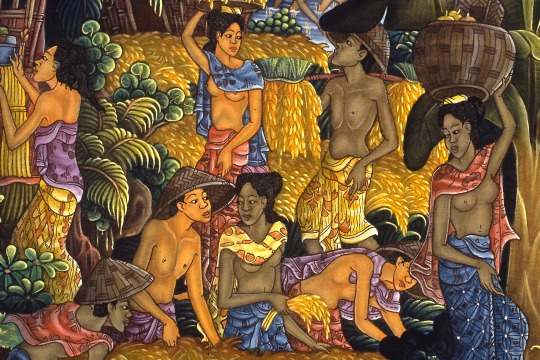 |
CULTURES IN CONTEXT Bali: Ancient and Modern 14. Processes of Change : 153-164 |

153. The Balinese have done more than most to preserve their values and traditional way of life. But no culture today is immune from the changes which flow from contact with different lifestyles, different values, and different technologies; also from economic and political pressures. |
154. Contact with international agencies, for example, has led to the introduction of a type of rice that grows more quickly. It comes in sacks and is scattered evenly over the seedbed. |
155. Its seedlings can be planted out in just three weeks, and they mature faster also… in three months instead of four. This means that three crops a year are possible now instead of two. |
156. This rice is still harvested by hand … by lines of reapers with sickles, who cut the stalks at ground level in the way wheat and rice are harvested in many countries. |
157. Instead of being taken home the grain is threshed there and then in the fields. It is beaten against rocks and collects in an area covered by woven mats and plastic sheets . |
158. The straw is kept for thatching and the grain is either carried home in sacks or taken first to a mill for polishing. With traditional varieties, in contrast, the husks were removed at home as and when required. |
159. Getting three crops a year instead of two sounds great, but there is a downside. Under the old system the land was usually rested for two months. Now there is less time for fields to lie fallow. These new varieties therefore require better soils and/or expensive fertilizers if yields are to be maintained. |
160. The number of mouths to be fed is also a challenge. Bali is only one twelfth the size of Tasmania but has 8 times as many people, and it is growing rapidly … due to a high birth rate and a long life expectancy. |
161. The government wants people to have smaller families. As you can see they think two children is enough. |
162. Tourism has ensured the survival of some traditional art forms, some of which demonstrate that traditional rice varieties are planted and harvested in the way they always have been. But increasing contact with secular societies already threatens traditional, spiritual values. |
163. There is little chance of industry developing in Bali; so while people can feed themselves easily enough they now depend on tourism for money to buy almost everything else. And when the number of visitors drops off, everybody suffers. Fewer souvenirs are sold, and fewer vehicles hired. |
164. Bali’s participation in international tourism has exposed it to the dangers of terrorism. When I was there, in 1984, it was still a quiet backwater of beauty and grace, an island paradise: but it is now, for better or worse, anchored in the mainstream. |
![]()
![]()
Text, photos and recordings
by John Tyman
Intended for Educational Use
Only.
Contact Dr. John Tyman at johntyman2@gmail.com
for information regarding public
or commercial use.
![]()
www.hillmanweb.com
Photo processing, Web page layout,
formatting and hosting by
William
Hillman ~ Brandon, Manitoba ~ Canada